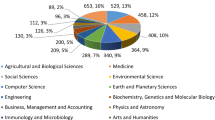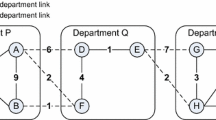Abstract
The purpose of this study is to explore the possibility of applying research collaboration as a new way of measuring research performance in Korean universities. In this study, we examine whether the activeness of research collaboration between university–government–industry can also enact as a way to measure the research performance aside from the typical indicators such as number of published articles or citations resulted from universities. Also this study focuses to analyze whether such performance differs according to universities’ characteristics and disciplines. For the analysis of the study, we gathered publication and citation data (2000–2009) of 46 Korean universities that are actively involved in research and analyzed their science citation index-expanded and the social sciences citation index (SSCI) data. Notable findings include (1) Several low ranked universities have shown rapid improvement with their research performance despite the rigid hierarchical characteristic of Korean higher education system, (2) Although universities in Korea are involved in various kinds of collaboration methods, it was evident that such dynamic is not necessarily reflected in existing hierarchy structure, (3) Academic relations with education oriented universities and research oriented universities have different dynamics and patterns in research collaboration, (4) In terms of the collaborative publication rate, private universities collaborate more actively amongst university sector whereas public universities collaborate more with government and industry. (5) Due to the nature of the social science subject itself, it was found that the research in SSCI is inevitably more based on the researcher’s independence, hence more international collaboration was found amongst researchers in natural science and engineering subjects.


Similar content being viewed by others
References
Abbasi, A., Altmann, J., & Hwang, J. (2010). Evaluating scholars based on their academic collaboration activities: Two indices, the RC-index and the CC-index, for quantifying collaboration activities of researchers and scientific communities. Scientometrics, 83(1), 1–13.
Abramo, G., D’angelo, C. A., & Solazzi, M. (2011). The relationship between scientists’ research performance and the degree of internationalization of their research. Scienctometrics, 86(3), 629–643.
Altbach, P. G. (2009). Peripheries and centers: Research universities in developing countries. Asia Pacific Education Review, 10(1), 15–27.
Bordons, M., Gomez, I., Fernandez, M. T., Zulueta, M. A., & Mendez, A. (1996). Local, domestic and international scientific collaboration in biomedical research. Scientometrics, 37(2), 279–295.
Choi, S. (2012). Core-periphery, new clusters, or rising stars? International scientific collaboration among ‘advanced’ countries in the era of globalization. Scientometrics, 90(1), 25–41.
Cummings, W., & Shin, J. C. (2013). Teaching and research in contemporary higher education: An overview. In Shin, J., Arimoto, A., Cummings, W. K., & Teichler, U. (Eds.). (forthcoming). Teaching and research in contemporary higher education: Systems, activities, nexus, and rewards.
Etzkowitz, H., & Leydesdorff, L. (1997). Universities and the global knowledge economy: A triple helix of university-industry-government relations. London: Francis Pinter.
Etzkowitz, H., & Leydesdorff, L. (2000). The dynamics of innovation: From national systems and “Mode 2” to a triple helix of university-industry-government relations. Research Policy, 29(2), 109–123.
Etzkowitz, H., Webster, A., Gebhardt, C., & Terra, B. (2000). The future of the university and the university of the future: Evolution of ivory tower to entrepreneurial paradigm. Research Policy, 29, 313–330.
Frenken, K., Ponds, R., & van Oort, F. (2010). The citation impact of research collaboration in science-based industries: A spatial-institutional analysis. Papers in Regional Science, 89(2), 351–371.
Gazni, A., & Didegah, F. (2011). Investigating different types of research collaboration and citation impact: A case study of Harvard University’s publications. Scientometrics, 87(2), 251–265.
Gibbons, M., Limoges, C., Nowotny, H., Schwartzman, S., Scott, P., & Trow, M. (1994). The new production of knowledge: The dynamics of science and research in contemporary societies. London: Sage.
Glanzel, W., & de Lange, C. (2002). A distributional approach to multinationality measures of international scientific collaboration. Scientometrics, 54(1), 75–89.
Jiang, Y. (2008). Locating active actors in the scientific collaboration communities based on interaction topology analyses. Scientometrics, 74(3), 471–482.
Katz, J. S., & Hicks, D. (1997). How much is a collaboration worth? A calibrated bibliometric model. Scientometrics, 40(3), 541–554.
Katz, J. S., & Martin, B. R. (1997). What is research collaboration? Research Policy, 26(1), 1–18.
King, R. (2004). The university in the global age. Houndsmills: Palgrave Macmillan.
Kwon, K. S., Park, H. W., So, M., & Leydesdorff, L. (2012). Has globalization strengthened South Korea’s national research system? National and international dynamics of the triple helix of scientific co-authorship relationships in South Korea. Scientometrics, 90(1), 163–175.
Landry, R., Traore, N., & Godin, B. (1996). An econometric analysis of the effect of collaboration on academic research productivity. Higher Education, 32(3), 283–301.
Narin, F., Stevens, K., & Whitlow, E. S. (1991). Scientific cooperation in Europe and the citation of multinationally authored papers. Scientometrics, 21(3), 313–323.
Park, H. W., & Leydesdorff, L. (2010). Longitudinal trends in networks of university-industry-government relations in South Korea: The role of programmatic incentives. Research Policy, 39(5), 640–649.
Porter, S. R., & Toutkoushian, R. K. (2006). Institutional research productivity and the connection to average student quality and overall reputation. Economics of Education Review, 25(6), 605–617.
Saphiro, M. A. (2012). Receiving information at Korean and Taiwanese universities, industry, and GRIs. Scientometrics, 90(1), 289–309.
Saxenian, A. L. (1994). Regional advantage: Culture and competition in Silicon Valley and route 128. Cambridge, MA: Harvard University Press.
Schmoch, U., & Schubert, T. (2008). Are international co-publications an indicator for quality of scientific research? Scientometrics, 74(3), 361–377.
Shin, J. C. (2009). Classifying higher education institutions in Korea: A performance-based approach. Higher Education, 57, 247–266.
Shin, J. C., & Cummings, W. (2010). Multilevel analysis of academic publishing across disciplines: Research preference, collaboration, and time on research. Scientometrics, 85, 581–594.
Shin, J. C., Lee, S. J., & Kim, Y. (2012). Knowledge-based innovation and collaboration: A triple-helix approach in Saudi Arabia. Scientometrics, 90(1), 311–326.
Shin, J. C., Toutkoushian, R. K., & Teichler, U. (2011). University rankings: Theoretical basis, methodology, and impacts on global higher education. Dordrecht: Springer.
Smeby, J. C., & Try, S. (2005). Departmental contexts and faculty research activity in Norway. Research in Higher Education, 46(6), 593–619.
Song, C.-H. (2003). Interdisciplinarity and knowledge inflow/outflow structure among science and engineering research in Korea. Scientometrics, 58(1), 129–141.
Stokes, T. D., & Hartley, J. A. (1989). Coauthorship, social structure and influence within specialities. Social Studies of Science, 19(1), 101–125.
Tijssen, R. J. W., van Leeuwen, T. N., & van Wijk, E. (2009). Benchmarking university-industry research cooperation worldwide: Performance measurements and indicators based on co-authorship data for the world’s largest universities. Research Evaluation, 18(1), 13–24.
Van Raan, A. F. J. (1998). The influence of international collaboration on the impact of research results-some simple mathematical considerations concerning the role of self-citations. Scientometrics, 42(3), 423–428.
Acknowledgments
This work was supported by the National Research Foundation of Korea Grant funded by the Korean Government (NRF-2010-330-B00232).
Author information
Authors and Affiliations
Corresponding author
Rights and permissions
About this article
Cite this article
Kim, Y., Lim, H.J. & Lee, S.J. Applying research collaboration as a new way of measuring research performance in Korean universities. Scientometrics 99, 97–115 (2014). https://doi.org/10.1007/s11192-013-1095-4
Received:
Published:
Issue Date:
DOI: https://doi.org/10.1007/s11192-013-1095-4




